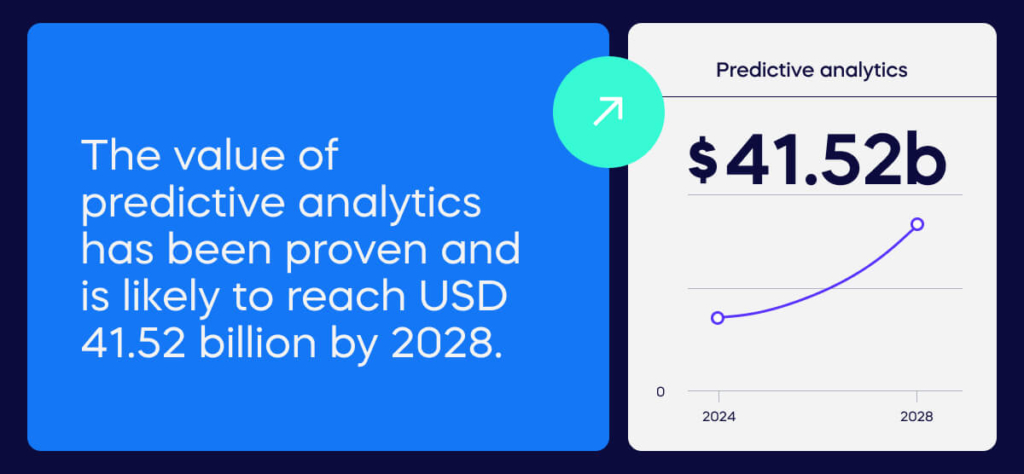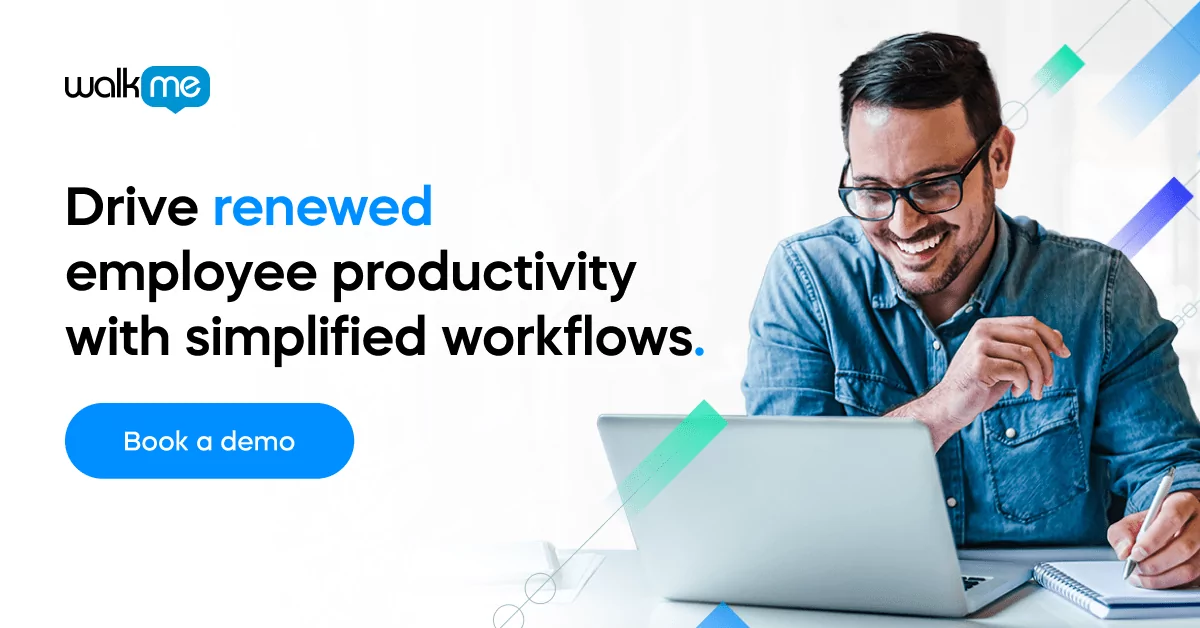Predictive analytics is revolutionizing industries, unlocking hidden insights for more intelligent decision-making.
Analyzing past data predicts future trends and events. It aids data-driven decision-making and increases digital resilience in manufacturing and retail industries.
The value of predictive analytics has been proven and is likely to reach USD 41.52 billion by 2028. Now is the time to invest. You will reap the benefits of this future-reading tech. It will let you compete on an even field in an uncertain market.

Now is the time to read the eleven examples and use cases below to help you understand the value of predictive analytics to your organization. Doing so will help you succeed as you include this technology within your digital transformation today.
What is predictive analytics?
Predictive analytics is like a crystal ball made of data. It analyzes past information to forecast future trends and events, helping businesses make strategic decisions.
These predictions can be immediate, like anticipating a machine malfunction. They can also be long-term, like projecting a company’s cash flow.
How it helps you predict future events drives smarter decisions and saves money. Saving money gives enterprises the competitive advantage of coming out on top.
11 examples of predictive analytics

Exploring industry-specific predictive analytics examples unveils how this powerful tool tackles unique challenges. It showcases its versatility and inspires creative applications within your field. This process allows you to increase your decision intelligence using data.
We have sorted these examples into industries and then by use case. The first and most frequent application for predictive analytics is in retail. Retail is the industry we will start with.
Industries
Understanding customer behavior is crucial to success in today’s competitive retail landscape. Predictive analytics empowers retailers beyond fundamental data analysis. Using this technique transforms customer information into actionable insights.
By anticipating future needs and trends, retailers can optimize various aspects of their business. Anticipating these needs creates a more efficient and customer-centric experience.
Let’s delve into some transformative ways predictive analytics shapes the retail industry.
Retail
Predictive analytics is a game-changer for retailers and has helped the retail market value increase to USD 5.23 trillion by the end of 2023. Anticipating customer needs and future trends allows them to optimize inventory management. It also allows you to target marketing campaigns.
This technology reduces stockouts, increases sales, and creates a more personalized shopping experience. It gives retailers a crucial edge in today’s competitive market. It also helps your retail organization beat competitors.
- Predictive marketing
Predictive analytics helps marketers predict customer needs and preferences. It allows targeted campaigns to resonate better and boost engagement and revenue.
A typical example involves a clothing retailer analyzing past purchases and browsing behavior. Retailers can use this data to predict which customers will likely buy a new coat in the fall. They then send targeted email campaigns with personalized recommendations. This outcome increases sales and customer satisfaction.
- Predictive inventory management
Predictive analytics within inventory management minimizes stockouts and overstock by forecasting demand for specific products and optimizing inventory levels.
One example is an online electronics store using historical sales data. They can use this data to predict future sales and ensure inventory is in place. This process avoids under- or overstocking.
Optimize inventory levels to avoid stockouts and costly overstock. This will ensure a smooth customer experience and lower storage costs.
- Predictive supply chain
Predictive analytics in the supply chain reduces disruptions and delays. It anticipates potential issues in delivery times and supplier performance.
Imagine a manufacturing company analyzing weather patterns and supplier performance to predict potential disruptions in raw material deliveries.
They proactively adjust production schedules and secure alternative suppliers, minimizing delays and production downtime.
Manufacturing
Predictive analytics empowers manufacturers to predict equipment failures. It can also optimize production processes and reduce downtimes. These benefits boost efficiency and save costs.
- Reducing malfunctions
The true power of predictive analytics in manufacturing lies in preventing problems. Doing so means not just anticipating future needs.
Imagine factories with algorithms analyzing historical data to predict equipment failures before they happen.
First, an impending malfunction is detected. Next, technicians receive alerts. They can then intervene and prevent a costly breakdown.
This process saves companies millions in damaged goods and repairs while avoiding production downtime.
Predictive analytics goes even further than prescriptive analytics. Here, the algorithms predict issues and recommend solutions. Preventative maintenance or performance adjustments are examples.
Manufacturers ensure smooth operations by proactively addressing potential problems. Addressing these problems saves time, money, and resources.
Insurance
Insurance companies can use predictive analytics to reduce claim likelihood. They can then set fairer premiums and reduce fraud. These benefits apply to themselves and their customers.
The first example of this is customer risk assessment.
- Risk assessment
In the insurance industry, predictive analytics is a game-changer for risk assessment. Insurance companies first analyze data, including driving records, health information, and home features. Insurers use this data to predict the likelihood of claims.
This approach allows them to set fairer premiums. Doing so will enable them to reward safe drivers and responsible homeowners with lower costs.
It also helps identify potential fraud. It reduces losses and customers by ensuring a healthy insurance pool.
Finance
Predictive analytics is essential for any finance organization for many reasons. These reasons will help it reach predictions of a market value of USD 2.5 billion by 2027.
These reasons mostly center around risk and retaining funds to lend to customers with the lowest financial risks.
Predictive analytics empowers finance to assess risk, predict market trends, and prevent fraud, leading to more innovative investments and reduced losses.
- Customer risk projections
Predictive analytics empowers financiers with foresight. They can predict future market trends, credit risks, and potential loan defaults by analyzing vast datasets.
Imagine a bank using historical data and customer spending habits to assess loan applications, make more informed decisions, and mitigate financial risks.
Banks use predictive analytics to reduce risk, tailor loan terms, streamline approvals, promote fairness, and reward responsible borrowers.
Social media
Social media is one of the best examples of where predictive analytics can shine, as platforms allow people to connect depending on social media companies’ ability to predict the next trend to meet user demand.
Predictive analytics personalizes social media experiences, boosting engagement and ad effectiveness using user behavior analysis to predict what content resonates with each user.
- User behavior analysis
Social media thrives on understanding user behavior. Predictive analytics helps platforms anticipate what content resonates with each user.
By analyzing past likes, shares, and comments, algorithms predict which posts and trends will grab attention.
This action allows platforms to personalize feeds, keeping users engaged and maximizing advertising effectiveness. Imagine seeing more content from creators you frequently interact with – that’s the power of predictive analytics tailoring your social media experience.
All enterprise organizations
HR departments can leverage predictive analytics to become proactive talent managers. By analyzing data like performance reviews, skills assessments, and past turnover trends, algorithms can identify employees at risk of leaving or underperforming.
This process allows HR to intervene early on, offering targeted training, career development opportunities, or addressing potential issues before they escalate.
The benefits are increased employee retention, improved skill development through optimized employee training, and a more engaged workforce, all of which contribute to a company’s overall success.
Use cases
Although looking at examples of predictive analytics by industry is helpful, it is also beneficial to consider them by use cases.
This approach can allow you to relate your needs to challenges you’ve had for which predictive analytics may provide the solution. These use cases involve Internet of Things applications, employee monitoring, image recognition, and detecting security breaches.
- IoT applications
Predictive analytics unlocks the true potential of IoT applications by transforming vast streams of sensor data into actionable insights.
Imagine factory machines constantly sending data on temperature, vibration, and energy usage. Predictive analytics can analyze this data to identify subtle changes that signal an impending malfunction.
Early warnings allow preventative maintenance, avoiding costly downtime and ensuring smooth operations. Similarly, smart thermostats with presence sensors can predict building occupancy and adjust heating/cooling, saving energy and money.
By anticipating future needs and potential problems, predictive analytics empowers proactive decision-making for a wide range of IoT applications.
- Employee monitoring
While controversial, employee monitoring with predictive analytics can identify potential issues and improve overall well-being. Companies can predict signs of burnout or disengagement by analyzing work patterns, communication frequency, and even keystroke patterns (with explicit employee consent).
Early intervention, such as offering additional support or workload adjustments, can prevent employee turnover and maintain a productive workforce.
- Image recognition on computer users
Image recognition with predictive analytics can enhance security and employee focus. Companies can identify signs of fatigue or distraction by analyzing employee posture and eye movement.
This technology could trigger gentle reminders to take breaks or refocus attention, preventing mistakes and accidents. However, leaders must consider privacy concerns when implementing such solutions.
- Detecting fraudulent cybersecurity breaches
Predictive analytics plays a vital role in cybersecurity by analyzing user behavior and network activity.
Companies can predict and prevent fraudulent breaches by identifying unusual access patterns, login attempts from unexpected locations, or deviations from typical data downloads.
This process allows them to take swift action, minimizing damage and protecting sensitive information.
Consider examples and use cases before investing in predictive analytics
Predictive analytics is a diverse tool that can benefit many industries and use cases.
Whether your organization works in manufacturing, finance, or retail, predictive analytics benefits every industry due to its diverse use cases.
However, no technology is useful without research and consideration. Consider the above examples and use cases before investing in predictive analytics to optimize its use and ensure ROI and financial sustainability in the coming years.


